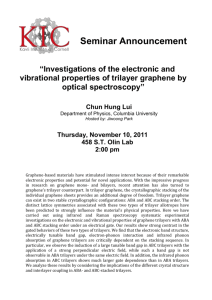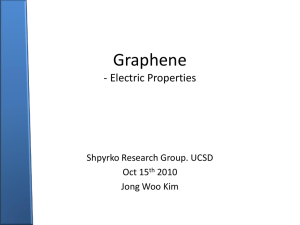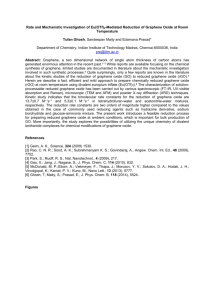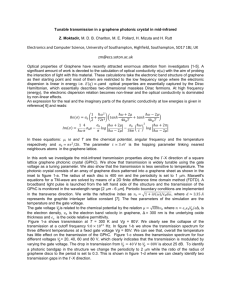140425_Supplemental
advertisement
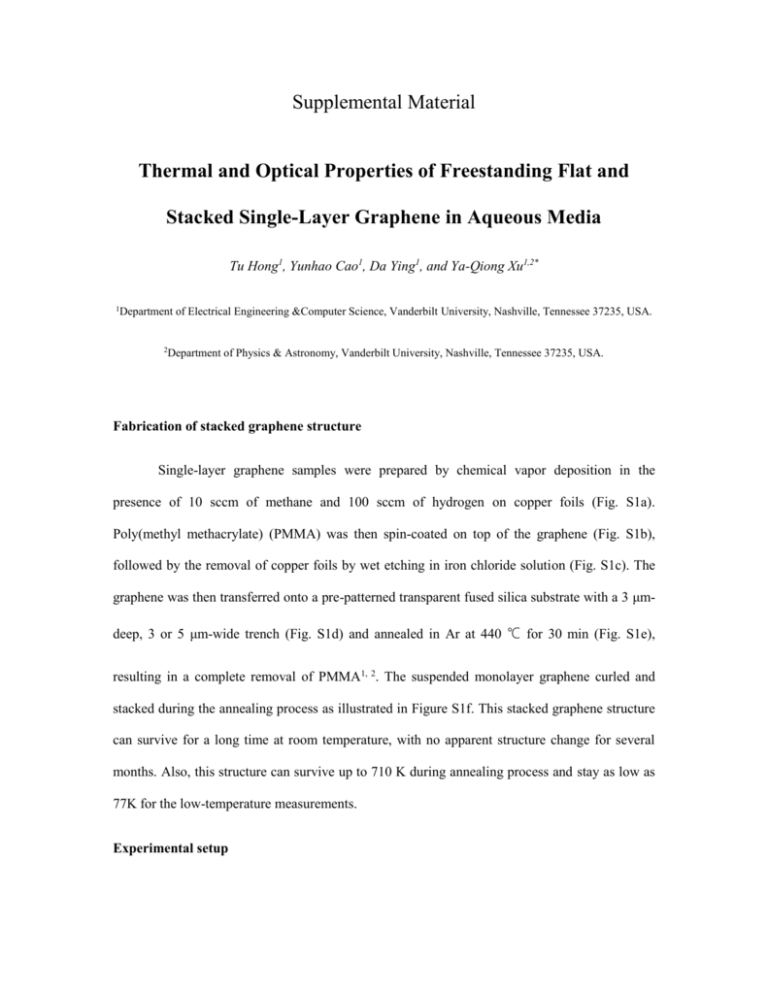
Supplemental Material Thermal and Optical Properties of Freestanding Flat and Stacked Single-Layer Graphene in Aqueous Media Tu Hong1, Yunhao Cao1, Da Ying1, and Ya-Qiong Xu1,2* 1 Department of Electrical Engineering &Computer Science, Vanderbilt University, Nashville, Tennessee 37235, USA. 2Department of Physics & Astronomy, Vanderbilt University, Nashville, Tennessee 37235, USA. Fabrication of stacked graphene structure Single-layer graphene samples were prepared by chemical vapor deposition in the presence of 10 sccm of methane and 100 sccm of hydrogen on copper foils (Fig. S1a). Poly(methyl methacrylate) (PMMA) was then spin-coated on top of the graphene (Fig. S1b), followed by the removal of copper foils by wet etching in iron chloride solution (Fig. S1c). The graphene was then transferred onto a pre-patterned transparent fused silica substrate with a 3 μmdeep, 3 or 5 μm-wide trench (Fig. S1d) and annealed in Ar at 440 ℃ for 30 min (Fig. S1e), resulting in a complete removal of PMMA1, 2. The suspended monolayer graphene curled and stacked during the annealing process as illustrated in Figure S1f. This stacked graphene structure can survive for a long time at room temperature, with no apparent structure change for several months. Also, this structure can survive up to 710 K during annealing process and stay as low as 77K for the low-temperature measurements. Experimental setup To explore the NIR emission from the graphene structures, a 785 nm (1.58 eV) laser was expanded and focused by a 40x objective (Olympus, N.A. = 0.6). The emission signal was filtered by an 850 nm long pass filter (Thorlabs) and collected by a liquid nitrogen cooled InGaAs detector (OMA-V, Princeton Instruments) in the NIR region (900 - 1600 nm). The NIR emission mapping was recorded by scanning a nanometer-resolution stage (Mad City Labs) and recording the emission signal in each position. The emission spectrum was recorded by an Acton SP2300 spectrometer (Princeton Instruments) coupled with the same detector. A calibration lamp of known temperature (Newport) was used for spectrum intensity calibration. All laser powers were measured at the objective. Estimation of graphene thermal conductivity We estimate the thermal conductivity κ of our graphene samples. The amount of heat Q transferred over time t through a cross section area S is given by the heat flow equation, 𝜕𝑄/ 𝜕𝑡 = −𝜅 ∮ ∇𝑇 ∙ 𝑑𝑆. Because the trench width (> 3 μm) is much larger than the laser spot size (~ 0.6 μm), the radial heat flow from the middle of the graphene to its boarders is dominating. In the case of suspended graphene ribbon, the thermal conductivity can be approximated by3 1 Δ𝑃 𝜅 = 2𝜋ℎ Δ𝑇 (1) where P is the total absorbed laser power, h = 0.335 nm is the graphene thickness. Previous studies report that the optical absorption of graphene is 2.3% over a broad spectrum range 4, 5. Since the interface thermal conductivity between graphene and air is relatively small, we ignore the thermal radiation into ambient air6, 7. The as-obtained graphene thermal conductivity κ is (927+560/-518) W m-1 K-1, with error source mainly from the Lorentzian fitting of the Raman peaks. This result is comparable to recently reported graphene thermal conductivity values by other groups7-10. Electrolyte gating of graphene and Fermi level calculation The graphene structure was sealed in a microfluidic chamber, in which 0.1 mM phosphate buffered saline (PBS) was used as the electrolyte gate material. A gold electrode was employed to change the gate voltage. When a gate voltage is applied, an electrical double layer is formed between the gate material and the graphene. The thickness of this electrical double layer is given by the Debye screening length, which is in the order of nanometers. At room temperature, the Debye screen length, d (nm), in aqueous media with ion concentration I (M) is approximated by11 𝑑 = 0.304 . √𝐼 Thus, the capacitance C of the system can be obtained by C= 𝜀𝜀0 𝑑 (2) where ε = 78.2 and ε0 = 8.854×1012 F/m are the permittivity of the gate material (water) and vacuum, respectively. The relationship between gate voltage Vg and carrier concentration n in single-layer graphene is given by12, 13 𝑉𝑔 − 𝑉𝐷𝑃 = 𝐸𝐹 𝑒 +𝜑 = ℏ𝑣F √𝜋𝑛 𝑒 + 𝑛𝑒 𝐶 (3) where VDP is the gate voltage at the Dirac point, EF = ℏ𝑣F √𝜋𝑛 is the Fermi energy, vF = 1.0×106 m/s is the Fermi velocity, and φ is the electrostatic potential difference between the gate electrode and the graphene. In this study, a gate voltage as high as ︱Vg-VDP︱ = 4.5 V was applied at an ion concentration of 1.0×10-4 M. We obtain a Fermi energy of 0.84 eV and a carrier concentration n = 5.2×1013 cm-2. Figure S1. Fabrication flow of freestanding stacked graphene References 1. J. D. Peterson, S. Vyazovkin and C. A. Wight, The Journal of Physical Chemistry B 103 (38), 8087-8092 (1999). 2. J. D. Peterson, S. Vyazovkin and C. A. Wight, Macromolecular Rapid Communications 20 (9), 480-483 (1999). 3. A. A. Balandin, S. Ghosh, W. Bao, I. Calizo, D. Teweldebrhan, F. Miao and C. N. Lau, Nano Letters 8 (3), 902-907 (2008). 4. R. R. Nair, P. Blake, A. N. Grigorenko, K. S. Novoselov, T. J. Booth, T. Stauber, N. M. R. Peres and A. K. Geim, Science 320 (5881), 1308 (2008). 5. F. Bonaccorso, Z. Sun, T. Hasan and A. C. Ferrari, Nature Photonics 4 (9), 611-622 (2010). 6. S. Chen, A. L. Moore, W. Cai, J. W. Suk, J. An, C. Mishra, C. Amos, C. W. Magnuson, J. Kang, L. Shi and R. S. Ruoff, Acs Nano 5 (1), 321-328 (2010). 7. J.-U. Lee, D. Yoon, H. Kim, S. W. Lee and H. Cheong, Physical Review B 83 (8), 081419 (2011). 8. C. Faugeras, B. Faugeras, M. Orlita, M. Potemski, R. R. Nair and A. K. Geim, Acs Nano 4 (4), 1889-1892 (2010). 9. W. Cai, A. L. Moore, Y. Zhu, X. Li, S. Chen, L. Shi and R. S. Ruoff, Nano Letters 10 (5), 1645-1651 (2010). 10. L. A. Jauregui, Y. Yue, A. N. Sidorov, J. Hu, Q. Yu, G. Lopez, R. Jalilian, D. K. Benjamin, D. A. Delkd and W. Wu, Ecs Transactions 28 (5), 73-83 (2010). 11. J. N. Israelachvili, Intermolecular and surface forces: revised third edition. (Academic press, 2011). 12. R. Saito, K. Sato, P. T. Araujo, D. L. Mafra and M. S. Dresselhaus, Solid State Commun 175-176 (0), 18-34 (2013). 13. A. Das, S. Pisana, B. Chakraborty, S. Piscanec, S. K. Saha, U. V. Waghmare, K. S. Novoselov, H. R. Krishnamurthy, A. K. Geim, A. C. Ferrari and A. K. Sood, Nature Nanotechnology 3 (4), 210-215 (2008).


